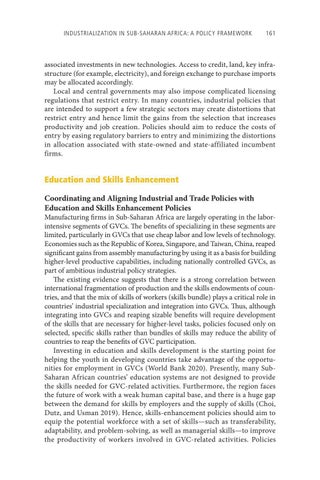INDUSTRIALIZATION IN SUB-SAHARAN AFRICA: A POLICY FRAMEWORK 161
associated investments in new technologies. Access to credit, land, key infrastructure (for example, electricity), and foreign exchange to purchase imports may be allocated accordingly. Local and central governments may also impose complicated licensing regulations that restrict entry. In many countries, industrial policies that are intended to support a few strategic sectors may create distortions that restrict entry and hence limit the gains from the selection that increases productivity and job creation. Policies should aim to reduce the costs of entry by easing regulatory barriers to entry and minimizing the distortions in allocation associated with state-owned and state-affiliated incumbent firms.
Education and Skills Enhancement Coordinating and Aligning Industrial and Trade Policies with Education and Skills Enhancement Policies
Manufacturing firms in Sub-Saharan Africa are largely operating in the laborintensive segments of GVCs. The benefits of specializing in these segments are limited, particularly in GVCs that use cheap labor and low levels of technology. Economies such as the Republic of Korea, Singapore, and Taiwan, China, reaped significant gains from assembly manufacturing by using it as a basis for building higher-level productive capabilities, including nationally controlled GVCs, as part of ambitious industrial policy strategies. The existing evidence suggests that there is a strong correlation between international fragmentation of production and the skills endowments of countries, and that the mix of skills of workers (skills bundle) plays a critical role in countries’ industrial specialization and integration into GVCs. Thus, although integrating into GVCs and reaping sizable benefits will require development of the skills that are necessary for higher-level tasks, policies focused only on selected, specific skills rather than bundles of skills may reduce the ability of countries to reap the benefits of GVC participation. Investing in education and skills development is the starting point for helping the youth in developing countries take advantage of the opportunities for employment in GVCs (World Bank 2020). Presently, many SubSaharan African countries’ education systems are not designed to provide the skills needed for GVC-related activities. Furthermore, the region faces the future of work with a weak human capital base, and there is a huge gap between the demand for skills by employers and the supply of skills (Choi, Dutz, and Usman 2019). Hence, skills-enhancement policies should aim to equip the potential workforce with a set of skills—such as transferability, adaptability, and problem-solving, as well as managerial skills—to improve the productivity of workers involved in GVC-related activities. Policies

